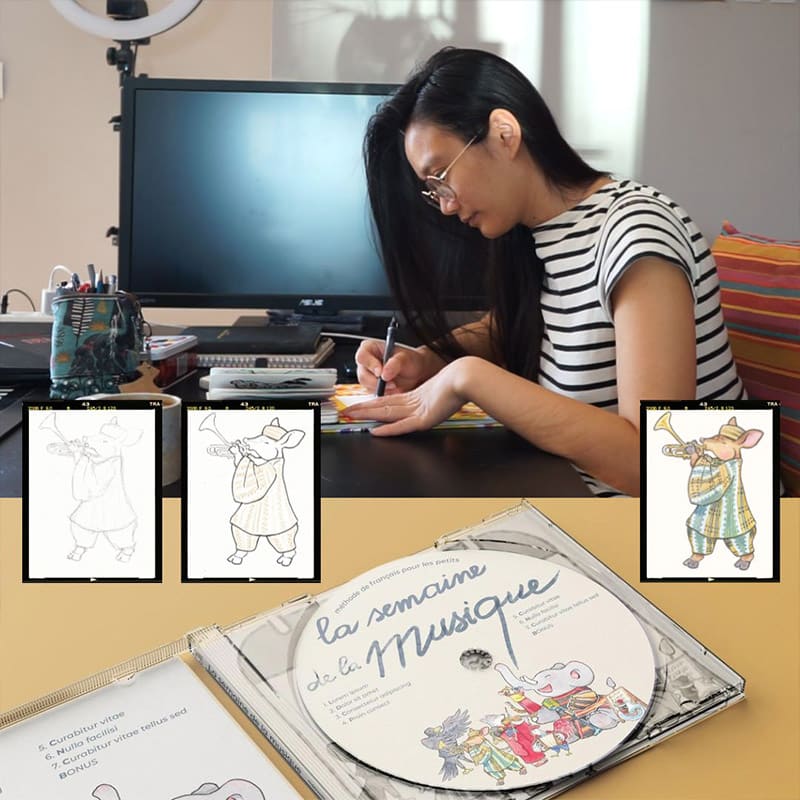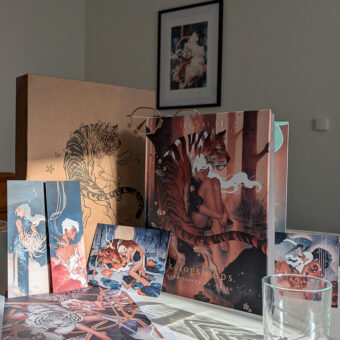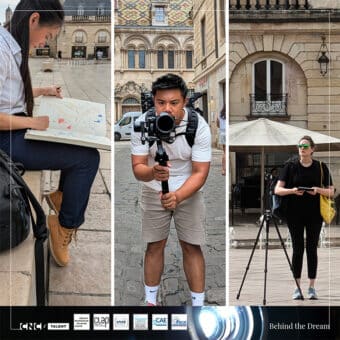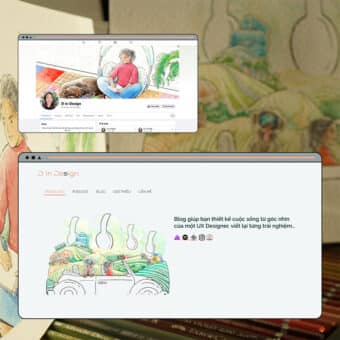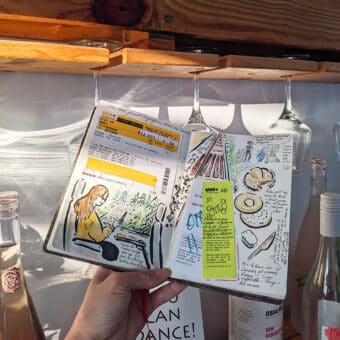Edited by my beloved friend K.L
This article is the second part of the article « Illustration: from start to end (client project): when discipline is the base of magic (1/2): It does NOT start with a line on a paper… » published on August 5, 2022.
Let’s continue to dive in the behind-the-scenes of an illustration creation process. In the last article, we broke down my client’s requirements, my research, and the reasoning behind each of my choices to build the compass that will guide all the following steps.
Today, we will go deeper into the “production” part.
If you haven’t read the first part of this series or if you don’t have all the details in your memory anymore, this project is a commission to illustrate the cover of an educational CD for the learning of the French language for the children. The illustration must reflect the lyrics of the song “La semaine de la musique”.
This article is accompanied by a video (in French with English subtitles).
Part two:
Creating with the heart of an artist and the mind of an engineer
As said in the brief (also see Part one), my client required the illustrations to be traditional, i.e. entirely handmade on paper with traditional drawing tools (as opposed to digital illustration).
Since the commission also includes the postcards of each character, in addition to the cover where the seven characters appear all together, I will have to make seven illustrations separately and assemble them afterwards.
(The materials used in all the following steps were mentioned in the article “My Watercolor Art Supplies to start an illustrator career“)
The sketch – the pillar
The first line on paper
Due to the size of the postcards and the CD cover, the challenge in this project is to find the perfect level of detail to draw. We need our animals to be fairly detailed on their individual postcard. However, when they are all printed in smaller size on the CD cover, we do not want the visual to be overloaded.
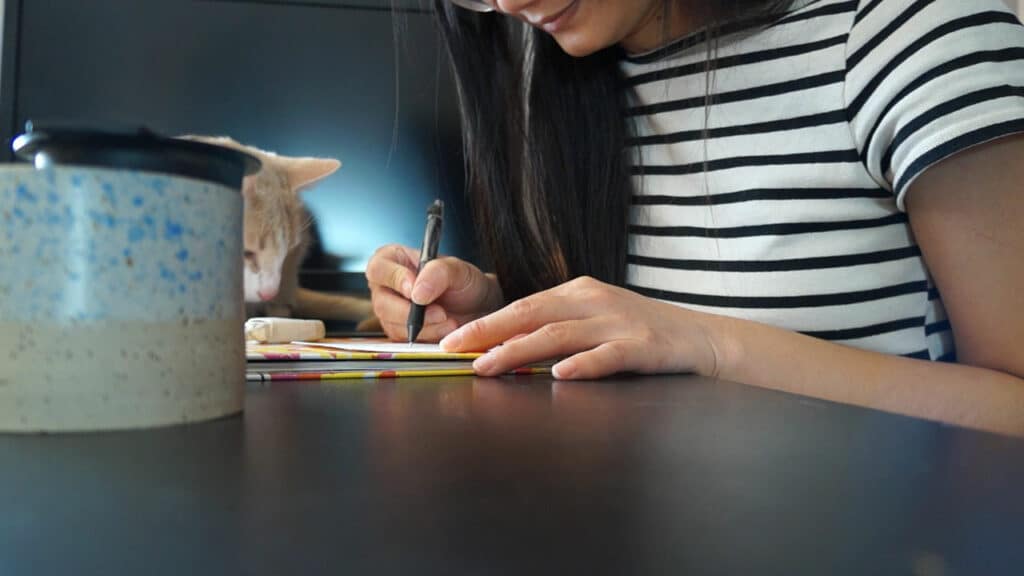
This is where I use the references that were collected in the previous step (see Part one) to build my sketches. At this stage, the pencil lines are still rough and coarse. The most important thing here is to allow my client to distinguish the proposed elements.
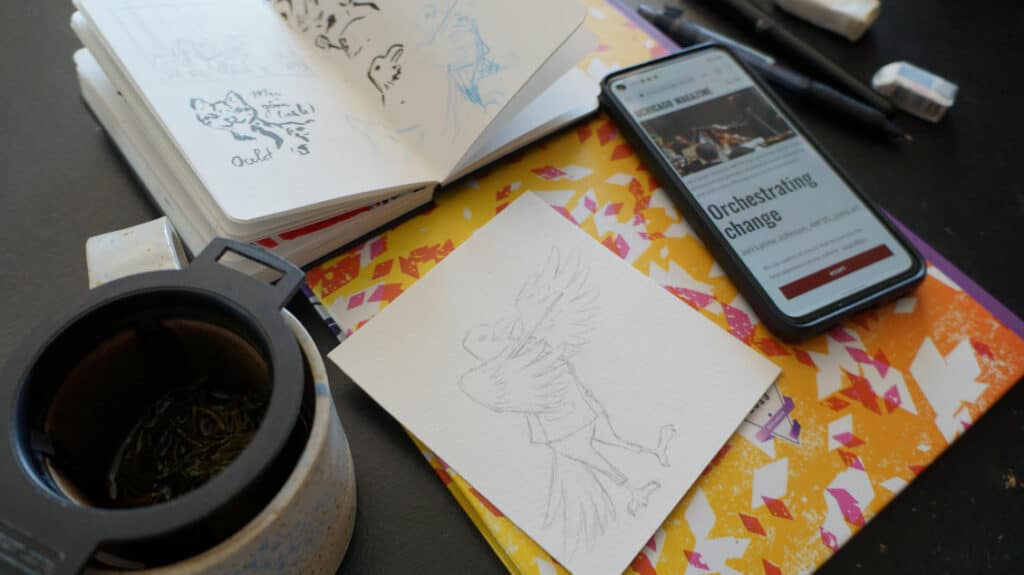
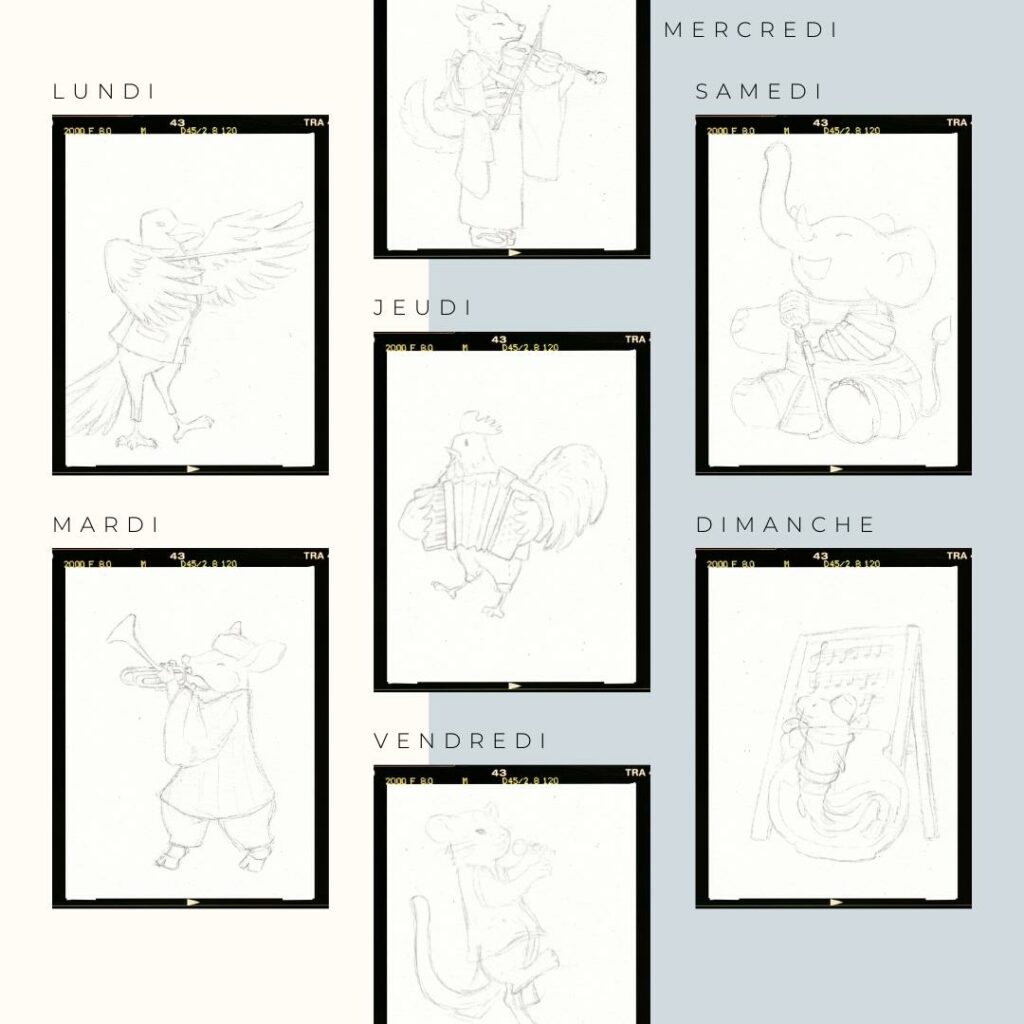
Time spent on the 7 sketches: 5 hours and 20 minutes
In most cases, I am able to find the balance of details by relying on experiences and how I take control of my own style. However, whenever production time allows, I would scan all the sketches and make a collage to test my estimation. I must have owed this urging habit of wanting to check thoroughly everything to my former profession in railway safety.

I also use this calibration to test the colors that I had in mind. Once I am sure of my proposal, I send it to my client.
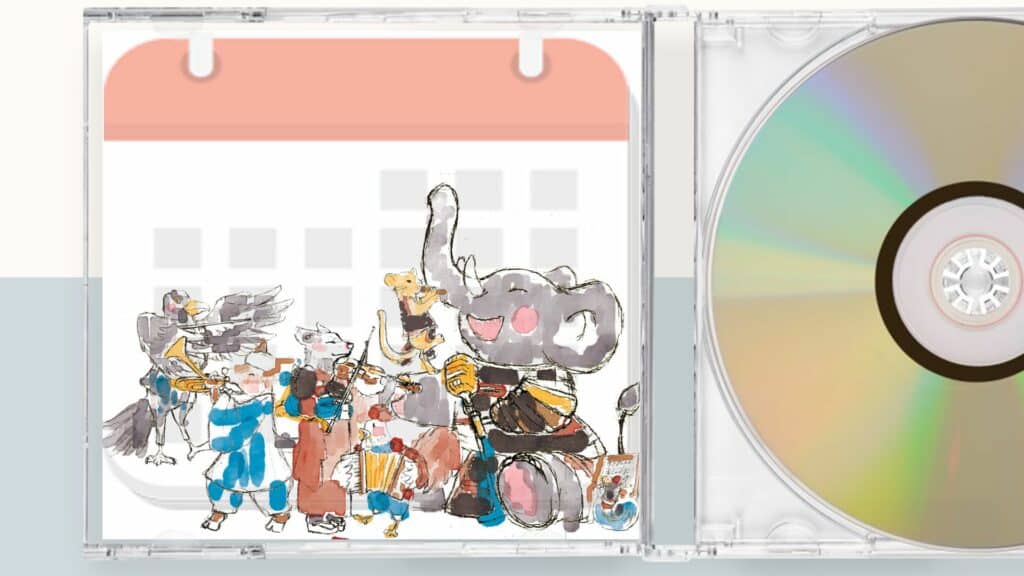
Time spent on making collage and colors test: 2 hours
The client’s feedback
As realistic of a creating process as I could promise to show you, we cannot pass by client feedback with change requests.
So far, the majority of my illustrations answer to my client’s expectation. However, there are two items they would like me to revise:
- #3-wednesday: We love the posture and the clothing. However, we think the wolf’s head looks too much like a fox’s.
- #5-Friday: We really like the marbled cat, but the cat is small, and the outfit seems to be too dark for the animal to be noticed. Can you get him some more colorful clothes, or maybe the traditional outfit from another country?
For the wolf, the necessary change is purely technical.
However, the case of the marbled cat requires more reflections. The marbled cat chosen is a rare species living in the Central Highlands, Vietnam. To ensure the consistency, I feel the necessity to find another country where this species lives and try draw the traditional outfit there, hopefully being somewhat more colorful than my original inspiration. While browsing the list of its habitats, one particular place caught my attention and lent me an equally particular inspiration: Bhutan, the land of happiness.
Personally, I really like the idea of a marbled cat of happiness dressed in a Bhutanese kira and wonju. In this way, instead of a duet Marbled cat “boy” – elephant “girl” of the Gia Rai ethnic group, Vietnam, we will have a duet of two “girls”: Bhutanese marbled cat and Vietnamese elephant.
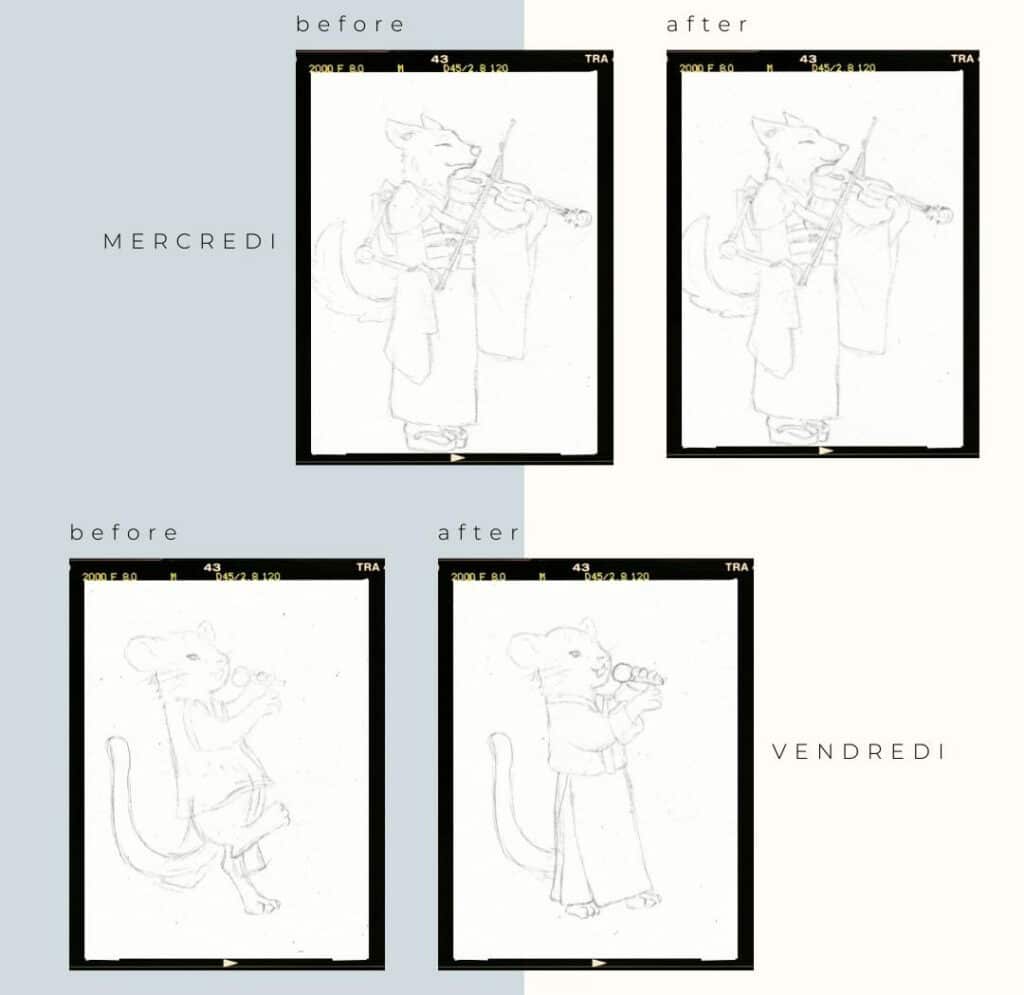
My client also approved this idea and gave me the green light to proceed.
Time spent on the modifications: 1 hour and 15 minutes
The research and sketching phase is over. We start the finalization phase with the step that I’m most worried about:
Inking – the point of no return
In traditional illustrations, from this stage on, the level of flexibility is drastically reduced. Once the black ink starts to flow under the movements of the pen, it will remain on the sheet forever.
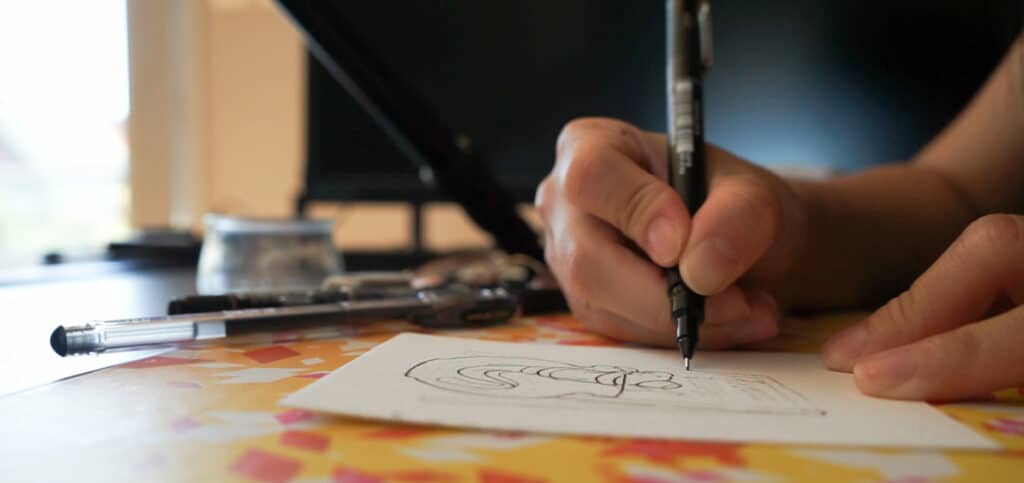
To be honest, despite years of practice, I still procrastinate before inking for fear of ruining my own cherished work.
To find a similar experience, this situation is exactly like the time when I stand on a Breton beach. The water is cold and getting into the water requires a lot of effort. But once I’m in, it is absolute happiness! Simpler than one would think, in such circumstance, the only solution is to just start inking, the pleasure will follow without a doubt!
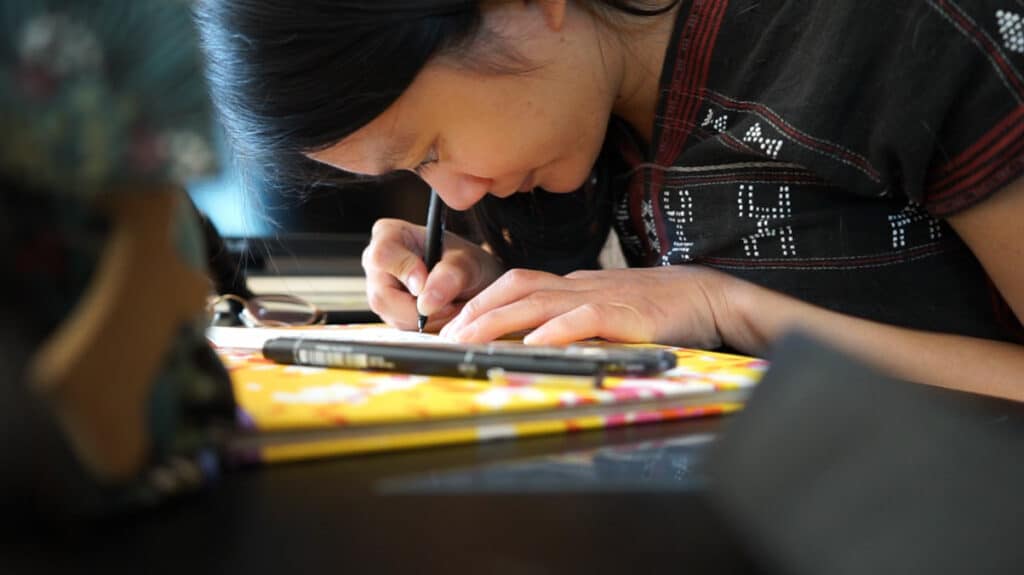
Time spent for inking: 2 hours 50 minutes
Once the inking with the black ink is done, I let the illustration dry for a day before erasing the gray pencil lines, to avoid accidents such as having the ink drooling under the rubbing of the eraser. There is no such thing as Ctrl+Z in traditional illustrations. For that reason, it is of utmost importance to be double careful.
To lighten the drawing, I ink some areas with watercolor pencils, because the strokes will dissolve during coloring and will not leave a visible outline.
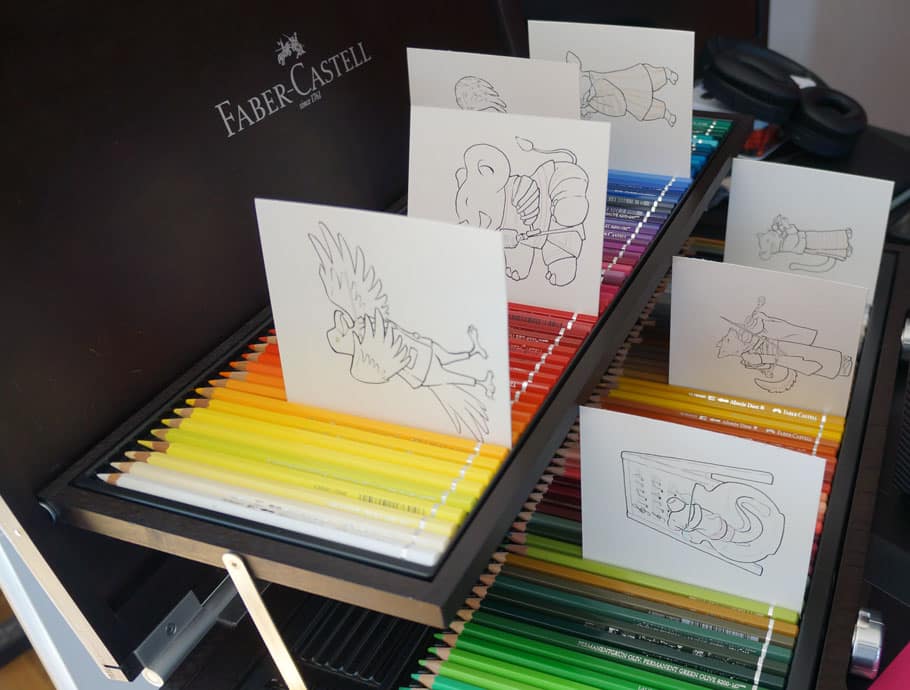
Time spent on the areas without visible contour: 1 hour 30 minutes
This step is only a preparation for the coloring, so I would not send this stage’s product to the clients. However, I always scan my inking before moving on to the most important, the most delicate and the most technical step:
Coloring – “Since she is my rose!”
Between chaos and poetry
The technique I use for most of my illustrations is watercolor. Even with years of practice, water always brings on an uncontrollable dimension of its own.
Yet, like the rose of the Little Prince, the traditional illustration is capricious, it is charming and authentic, fragile and unique. No digital technique can replace the sound of the pencil on the paper or the feeling when the skin slides on the grains of sheets. Every hesitation, every excitement, every surprise discovery, every “Oops!” of no return is forever and ever set down on paper.
I fell in love with watercolor the moment I saw the trace of water mixed with color shine under the light. Its unpredictability gives me a thrill throughout the creation process. Watercolor also forces me to be patient waiting for the color to dry before I can come in with a new layer. However, it is also these moments of pause that give me the perspective that I would dearly need during my creation process.
At a corner of my heart of an artist, I am always grateful when my clients share the same sensitivity as mine and trust me into choosing traditional illustration for their projects.
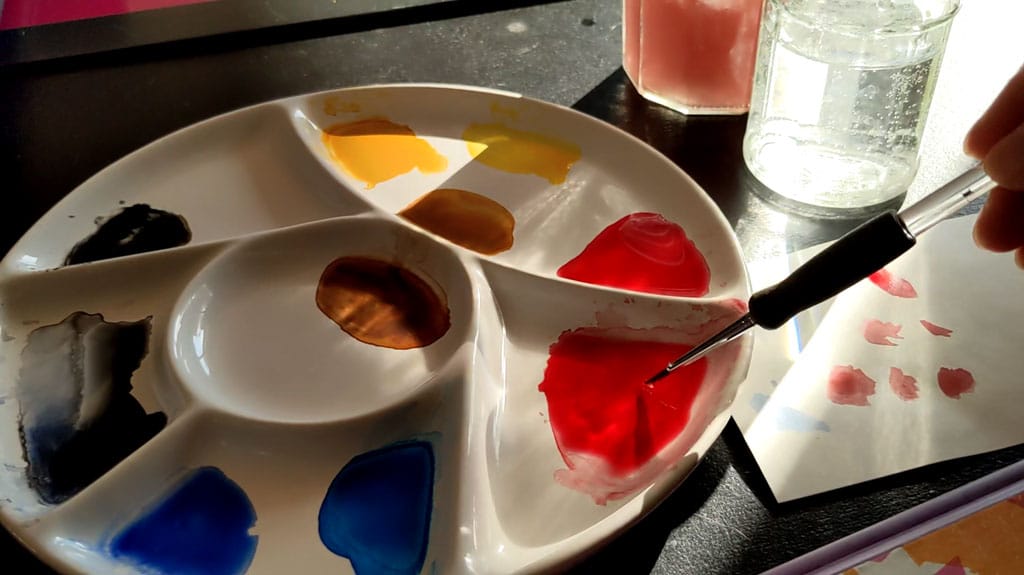
However, whenever I am satisfied with a step in the process, it is the next step that always gives me anxiety for fear of damaging any progress that I have made so far. Therefore, I frequently scan my illustrations in progress to keep a record of those satisfying moments (and to avoid the procrastination caused by hesitation).
But mostly, I scan to have a backup. In safety field where I used to work, we constantly repeat that there is no such thing as zero risk! I cannot be sure that I will never make a mistake or that no external event can damage my artwork. The scans allow me to have a Ctrl+Z in real life to respect the deadlines and keep the quality level even in case of an incident. All I have to do is to print the last completed step and continue on the same path instead of redrawing everything.
Time spent on coloring: 8 hours 40 minutes
And what about inspiration?
In reality, inspiration does not remain constant from the beginning to the end of a project. As it is in any other profession, there are some good days and some bad days.
There are some days when you just have to follow your intuition, when every stroke seems easy and effortless. These days would look pretty much like the image of the creative profession that you encounter on social networks. But there are also days when everything seems heavy and difficult, when motivation runs low, when nothing goes as planned.
However, when you are at professional level, the gap between your good days and your bad days should not be recoginzed in the final product. If inspiration does not show up at the beginning of the working day, discipline takes over.
Personally, the pleasure I feel with my work is not only fulfilled when my inspiration is filled to the brim. The satisfaction is also in the accomplishment when my inspiration falls silent and a beautiful drawing is born through conscious effort and control.
However, even in these moments, a breeze of inspiration continues to be by my side through the list of notes that I keep filling in throughout the process whenever inspiration would blow me an idea (see Part one) .
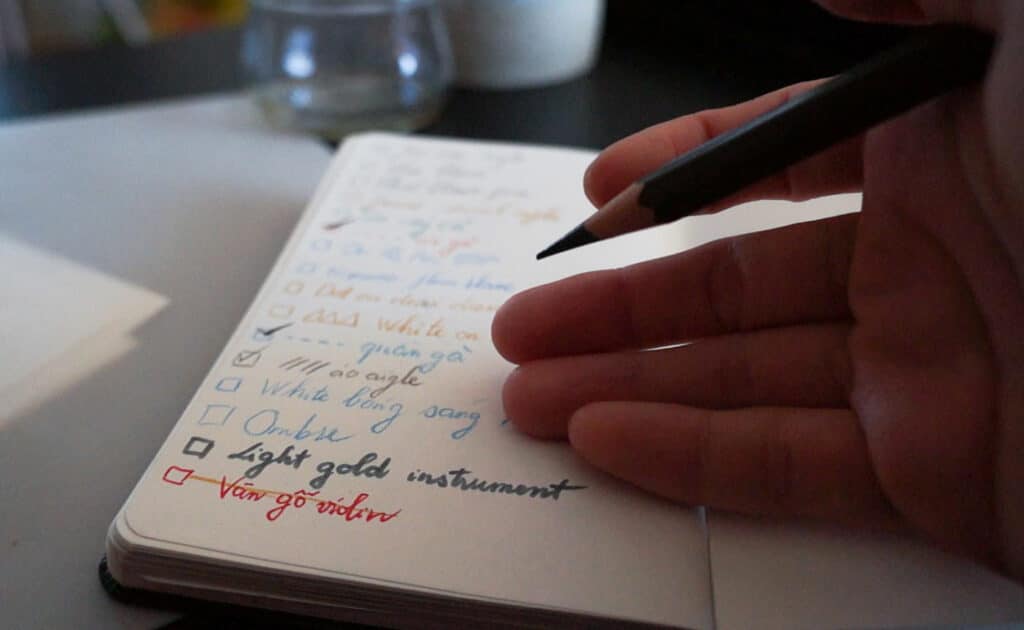
Small detail, big impact
Bearing a painful resemblance to how tailoring or leatherwork is, it is often in the small finishing details that give the design a polished look and amplify the value of the final work.
Once the watercolor coloring is done, I take out the list of notes and apply all the planned details.
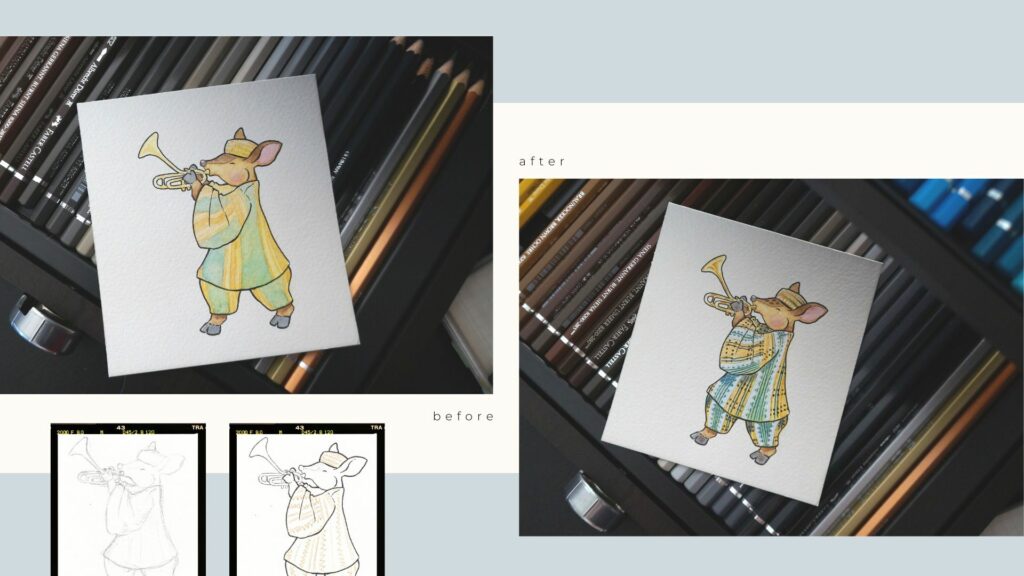
Time spent to add all the details: 2 hours 45 minutes
The finish line
Even if the illustration is made in traditional method, the illustration must be delivered to the client in digital format because its purpose is to be printed on a CD cover. And when it comes to digital file, files specifications are of great importance and a careful preparation to render these files to obtain an optimal quality is indispensable.
The treatment
This step consists of cleaning the scanned drawing to remove traces of dust on the sheet or on the glass of the scanner and to detach the characters from the background. I would also make use of this step to do some retouching so that the scanned version looks as close as possible to the original.
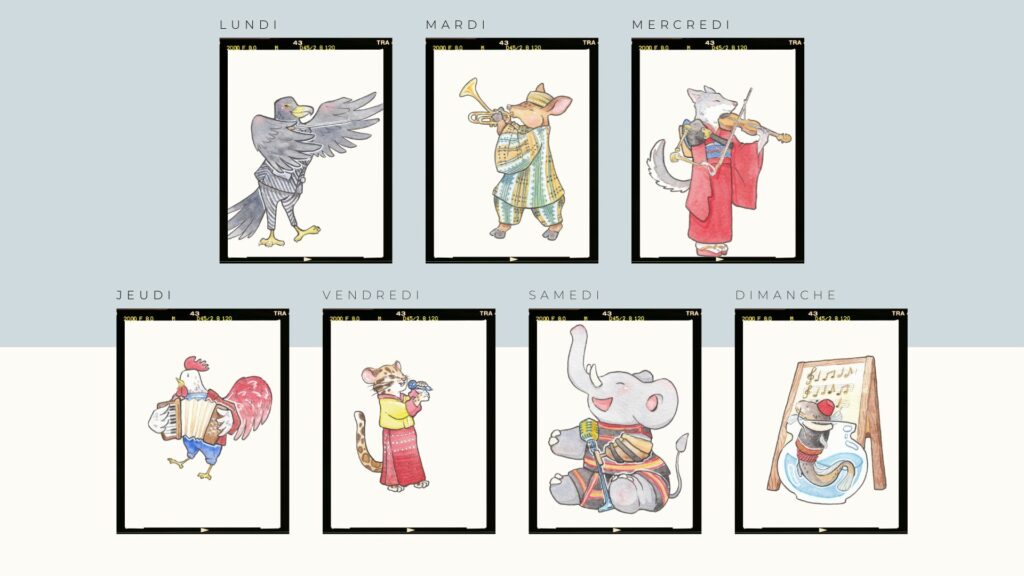
Time spent for the treatment: 2 hours and 10 minutes
The assembly
Finally, it’s time to place the characters next to each other following the order of the days of the week.
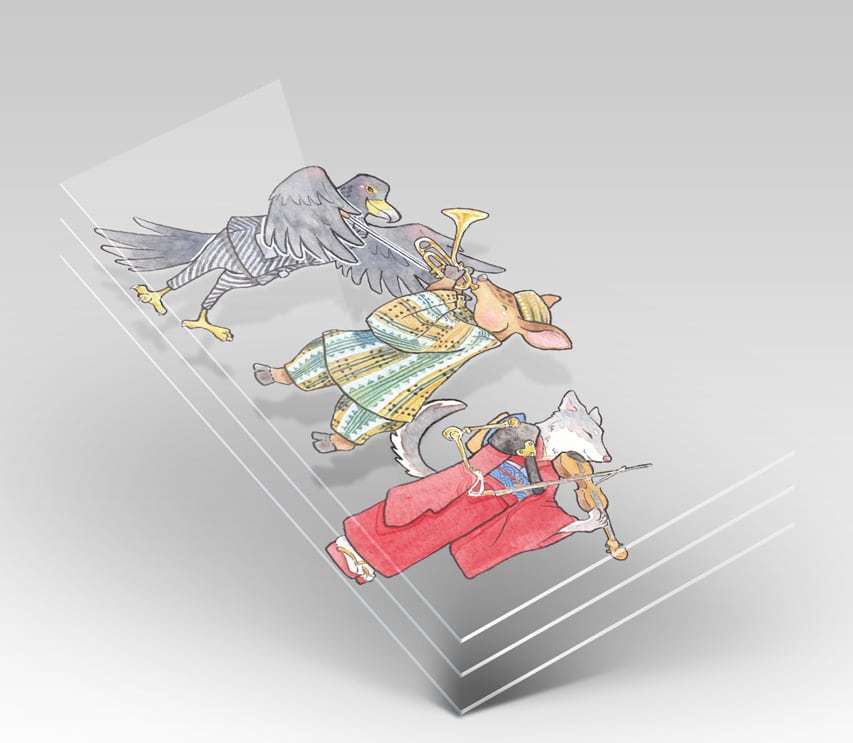
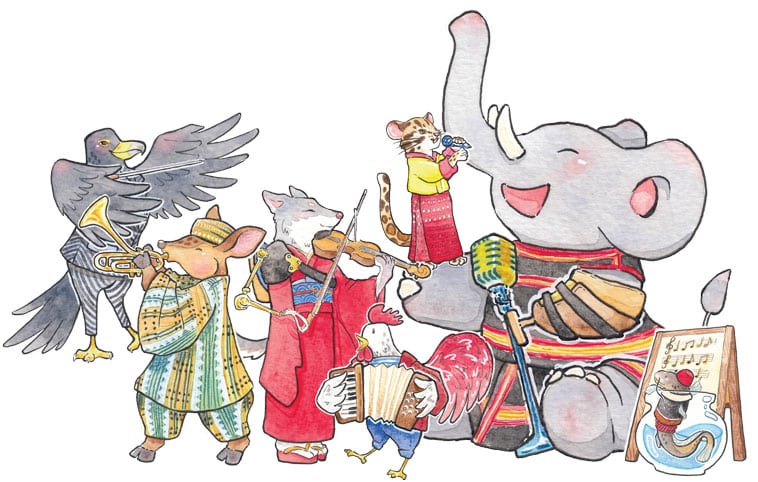
Time spent for the assembly: 1 hour and 30 minutes
My work is done when I send the illustration files to my client. Normally, even if I can imagine more or less the final product based on the layout provided by the client and on my assembly, I also have to wait for the client’s graphic designer to do their work before I can see the final result. In most cases, I discover it at the same time as the public.
(If you are curious about the distinction between the profession of illustrator and the profession of graphic designer, you can consult my article “What is the difference between an illustrator and a graphic designer?”)
But of course, I cannot end the article here without revealing you how my 7 animals on the CD cover would look like.
The week of music
And here is the long-awaited result:
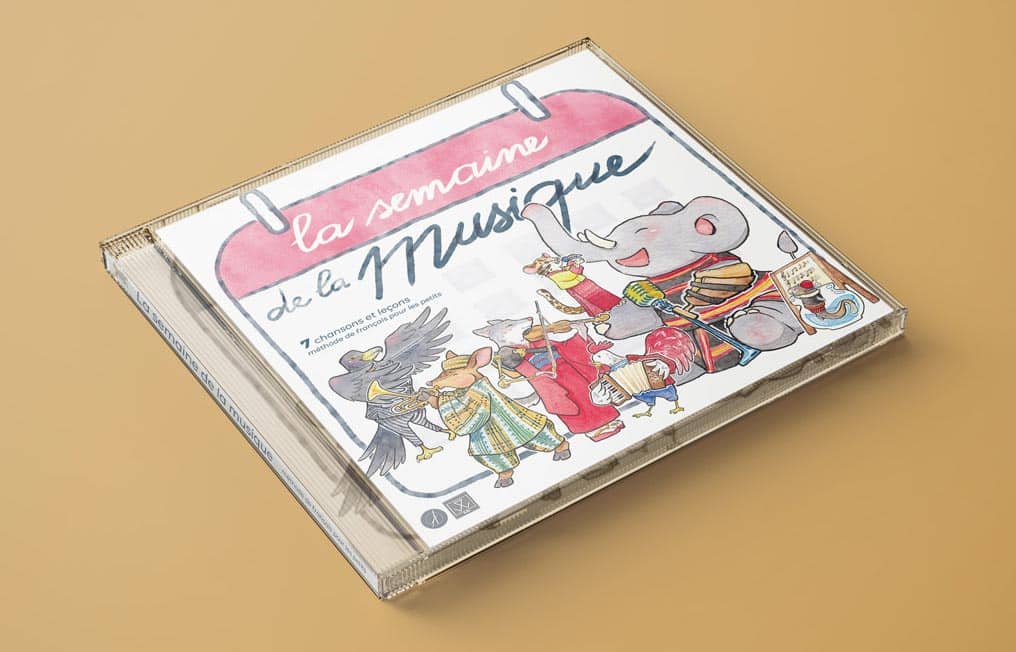
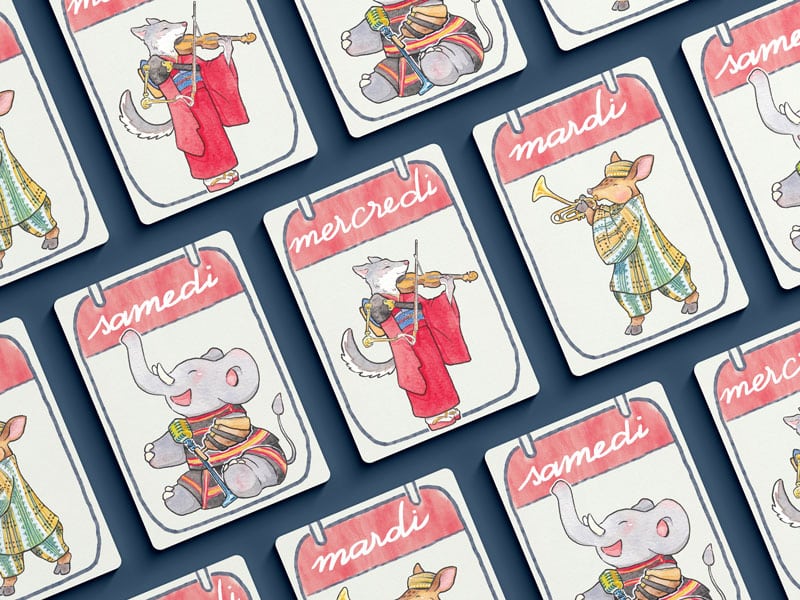
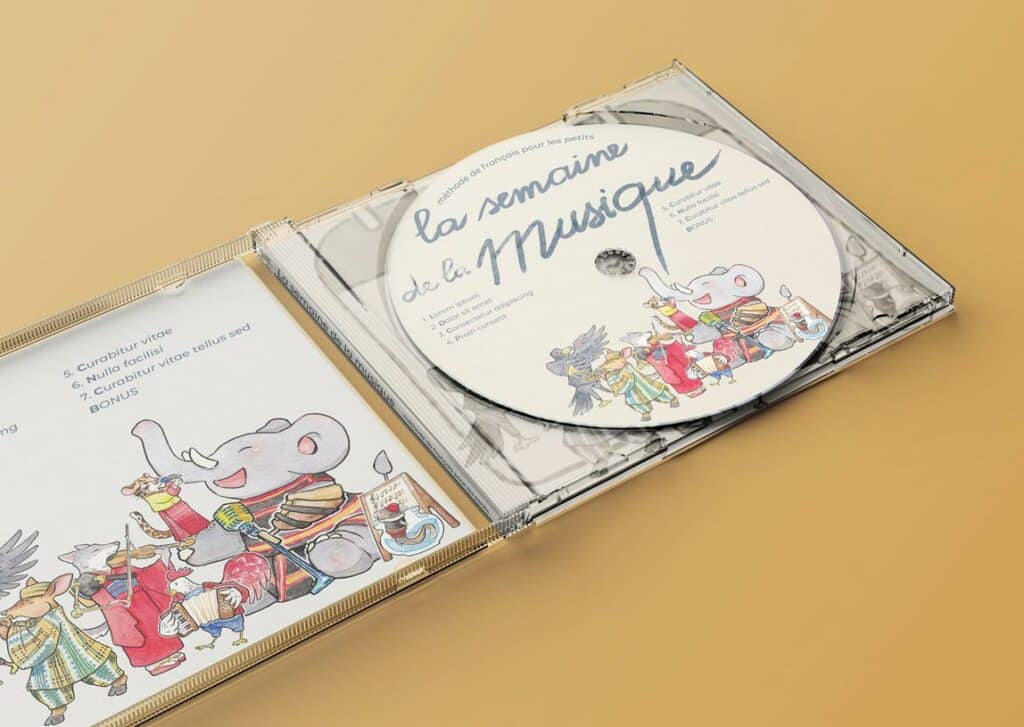
From start to end
Finally, how much time did I spend on this project?
If we sum up the hours of pure production listed at the end of each chapter, the total duration is: 31 hours and 30 minutes, which doesn’t count the mandatory waiting time (incubation (see Part one), drying time…)
In reality, we must also include small tasks such as preparing files and presentations to be sent during the various validation phases, exchanges with the client, etc. Small note is the number of modifications is often agreed upon with the client before the beginning of each project.
On the client’s side, the time to study each proposal and the incubation time must also be considered.
The creation of a project similar to our simulation from the beginning to the end would usually take about 2.5 to 3 weeks.
A commercial illustration is (perhaps) not a masterpiece…
My illustrations are not created to be exhibited in a museum in the future. I would just like to create a brick that would contribute to convey messages, to underline values, to act on the present world.
Answering to what my client is looking for is for me to play the role of artist, entrepreneur, technician, advisor, and I think this is where lies the richness of my profession.
If you have an editorial, corporate, or commercial project, or if you would like to share any of your sensitivity about cultural diversity, don’t hesitate to come and talk to me by any means possible, over a coffee, by video conference or by email. Maybe we can bring them to life together….
Keep creating!
Tu Ha An
*Please consult the information on Copyright & Intellectual Property before copying or mentioning the content and images of tuhaan.com



